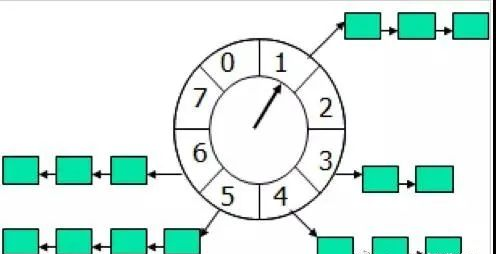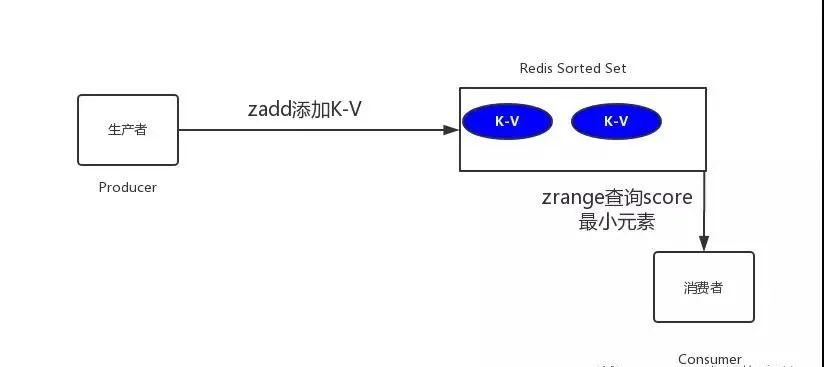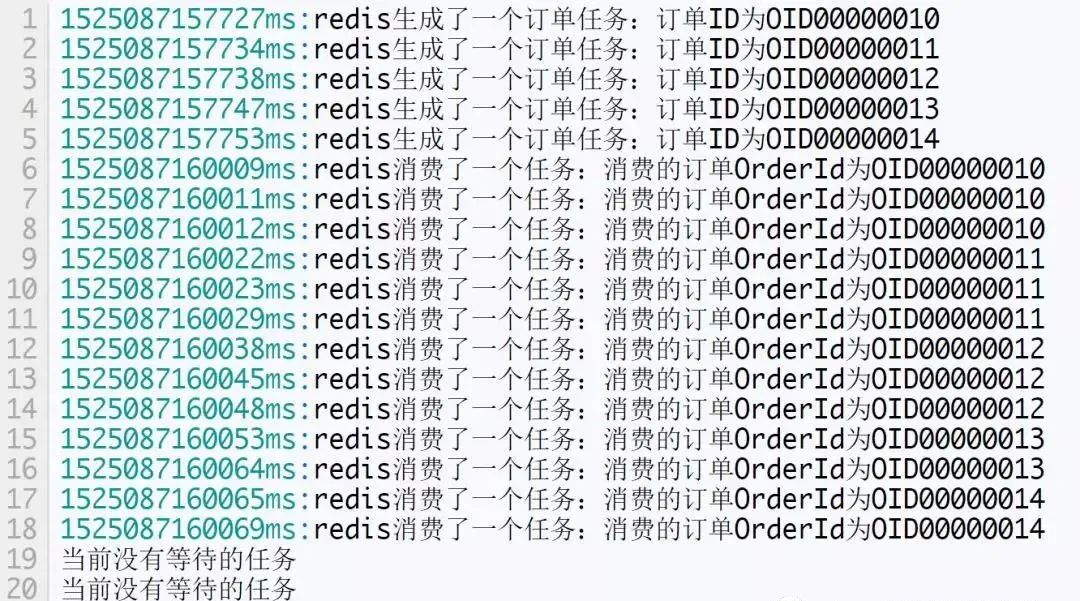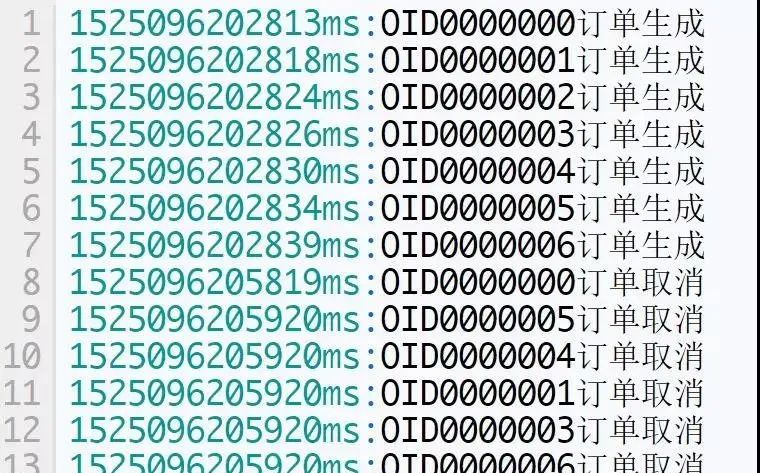生成订单30分钟未支付,则自动取消,该怎么实现?
阅读本文大概需要 10 分钟。
来自:https://blog.csdn.net/hjm4702192/article/details/80519010
# 引言
生成订单30分钟未支付,则自动取消
生成订单60秒后,给用户发短信
定时任务有明确的触发时间,延时任务没有
定时任务有执行周期,而延时任务在某事件触发后一段时间内执行,没有执行周期
定时任务一般执行的是批处理操作是多个任务,而延时任务一般是单个任务
# 方案分析
(1)数据库轮询
思路
实现
maven项目引入一个依赖如下所示
<dependency><groupId>org.quartz-scheduler</groupId><artifactId>quartz</artifactId><version>2.2.2</version></dependency>
package com.rjzheng.delay1;import org.quartz.JobBuilder;import org.quartz.JobDetail;import org.quartz.Scheduler;import org.quartz.SchedulerException;import org.quartz.SchedulerFactory;import org.quartz.SimpleScheduleBuilder;import org.quartz.Trigger;import org.quartz.TriggerBuilder;import org.quartz.impl.StdSchedulerFactory;import org.quartz.Job;import org.quartz.JobExecutionContext;import org.quartz.JobExecutionException;public class MyJob implements Job {public void execute(JobExecutionContext context)throws JobExecutionException {System.out.println("要去数据库扫描啦。。。");}public static void main(String[] args) throws Exception {// 创建任务JobDetail jobDetail = JobBuilder.newJob(MyJob.class).withIdentity("job1", "group1").build();// 创建触发器 每3秒钟执行一次Trigger trigger = TriggerBuilder.newTrigger().withIdentity("trigger1", "group3").withSchedule(SimpleScheduleBuilder.simpleSchedule().withIntervalInSeconds(3).repeatForever()).build();Scheduler scheduler = new StdSchedulerFactory().getScheduler();// 将任务及其触发器放入调度器scheduler.scheduleJob(jobDetail, trigger);// 调度器开始调度任务scheduler.start();}}
要去数据库扫描啦。。。
DelayedQueue实现工作流程如下图所示

take():获取并移除队列的超时元素,如果没有则wait当前线程,直到有元素满足超时条件,返回结果。
实现
package com.rjzheng.delay2;import java.util.concurrent.Delayed;import java.util.concurrent.TimeUnit;public class OrderDelay implements Delayed {private String orderId;private long timeout;OrderDelay(String orderId, long timeout) {this.orderId = orderId;this.timeout = timeout + System.nanoTime();}public int compareTo(Delayed other) {if (other == this)return 0;OrderDelay t = (OrderDelay) other;long d = (getDelay(TimeUnit.NANOSECONDS) - t.getDelay(TimeUnit.NANOSECONDS));return (d == 0) ? 0 : ((d < 0) ? -1 : 1);}// 返回距离你自定义的超时时间还有多少public long getDelay(TimeUnit unit) {return unit.convert(timeout - System.nanoTime(),TimeUnit.NANOSECONDS);}void print() {System.out.println(orderId+"编号的订单要删除啦。。。。");}}
package com.rjzheng.delay2;import java.util.ArrayList;import java.util.List;import java.util.concurrent.DelayQueue;import java.util.concurrent.TimeUnit;public class DelayQueueDemo {public static void main(String[] args) {// TODO Auto-generated method stubList<String> list = new ArrayList<String>();list.add("00000001");list.add("00000002");list.add("00000003");list.add("00000004");list.add("00000005");DelayQueue<OrderDelay> queue = newDelayQueue<OrderDelay>();long start = System.currentTimeMillis();for(int i = 0;i<5;i++){//延迟三秒取出queue.put(new OrderDelay(list.get(i),TimeUnit.NANOSECONDS.convert(3,TimeUnit.SECONDS)));try {queue.take().print();System.out.println("After " +(System.currentTimeMillis()-start) + " MilliSeconds");} catch (InterruptedException e) {// TODO Auto-generated catch blocke.printStackTrace();}}}}
00000001编号的订单要删除啦。。。。After 3003 MilliSeconds00000002编号的订单要删除啦。。。。After 6006 MilliSeconds00000003编号的订单要删除啦。。。。After 9006 MilliSeconds00000004编号的订单要删除啦。。。。After 12008 MilliSeconds00000005编号的订单要删除啦。。。。After 15009 MilliSeconds
优缺点
缺点:
(2)集群扩展相当麻烦
(3)因为内存条件限制的原因,比如下单未付款的订单数太多,那么很容易就出现OOM异常
(4)代码复杂度较高
(3)时间轮算法
思路

实现
给Pom加上下面的依赖
<dependency><groupId>io.netty</groupId><artifactId>netty-all</artifactId><version>4.1.24.Final</version></dependency>
package com.rjzheng.delay3;import io.netty.util.HashedWheelTimer;import io.netty.util.Timeout;import io.netty.util.Timer;import io.netty.util.TimerTask;import java.util.concurrent.TimeUnit;public class HashedWheelTimerTest {static class MyTimerTask implements TimerTask{boolean flag;public MyTimerTask(boolean flag){this.flag = flag;}public void run(Timeout timeout) throws Exception {// TODO Auto-generated method stubSystem.out.println("要去数据库删除订单了。。。。");this.flag =false;}}public static void main(String[] argv) {MyTimerTask timerTask = new MyTimerTask(true);Timer timer = new HashedWheelTimer();timer.newTimeout(timerTask, 5, TimeUnit.SECONDS);int i = 1;while(timerTask.flag){try {Thread.sleep(1000);} catch (InterruptedException e) {// TODO Auto-generated catch blocke.printStackTrace();}System.out.println(i+"秒过去了");i++;}}}
1秒过去了2秒过去了3秒过去了4秒过去了5秒过去了要去数据库删除订单了。。。。6秒过去了
添加元素:ZADD key score member [[score member] [score member] …]
按顺序查询元素:ZRANGE key start stop [WITHSCORES]
查询元素score:ZSCORE key member
移除元素:ZREM key member [member …]
# 添加单个元素redis> ZADD page_rank 10 google.com(integer) 1# 添加多个元素redis> ZADD page_rank 9 baidu.com 8 bing.com(integer) 2redis> ZRANGE page_rank 0 -1 WITHSCORES1) "bing.com"2) "8"3) "baidu.com"4) "9"5) "google.com"6) "10"# 查询元素的score值redis> ZSCORE page_rank bing.com"8"# 移除单个元素redis> ZREM page_rank google.com(integer) 1redis> ZRANGE page_rank 0 -1 WITHSCORES1) "bing.com"2) "8"3) "baidu.com"4) "9"

实现一
package com.rjzheng.delay4;import java.util.Calendar;import java.util.Set;import redis.clients.jedis.Jedis;import redis.clients.jedis.JedisPool;import redis.clients.jedis.Tuple;public class AppTest {private static final String ADDR = "127.0.0.1";private static final int PORT = 6379;private static JedisPool jedisPool = new JedisPool(ADDR, PORT);public static Jedis getJedis() {return jedisPool.getResource();}//生产者,生成5个订单放进去public void productionDelayMessage(){for(int i=0;i<5;i++){//延迟3秒Calendar cal1 = Calendar.getInstance();cal1.add(Calendar.SECOND, 3);int second3later = (int) (cal1.getTimeInMillis() / 1000);AppTest.getJedis().zadd("OrderId",second3later,"OID0000001"+i);System.out.println(System.currentTimeMillis()+"ms:redis生成了一个订单任务:订单ID为"+"OID0000001"+i);}}//消费者,取订单public void consumerDelayMessage(){Jedis jedis = AppTest.getJedis();while(true){Set<Tuple> items = jedis.zrangeWithScores("OrderId", 0, 1);if(items == null || items.isEmpty()){System.out.println("当前没有等待的任务");try {Thread.sleep(500);} catch (InterruptedException e) {// TODO Auto-generated catch blocke.printStackTrace();}continue;}int score = (int) ((Tuple)items.toArray()[0]).getScore();Calendar cal = Calendar.getInstance();int nowSecond = (int) (cal.getTimeInMillis() / 1000);if(nowSecond >= score){String orderId = ((Tuple)items.toArray()[0]).getElement();jedis.zrem("OrderId", orderId);System.out.println(System.currentTimeMillis() +"ms:redis消费了一个任务:消费的订单OrderId为"+orderId);}}}public static void main(String[] args) {AppTest appTest =new AppTest();appTest.productionDelayMessage();appTest.consumerDelayMessage();}}

package com.rjzheng.delay4;import java.util.concurrent.CountDownLatch;public class ThreadTest {private static final int threadNum = 10;private static CountDownLatch cdl = newCountDownLatch(threadNum);static class DelayMessage implements Runnable{public void run() {try {cdl.await();} catch (InterruptedException e) {// TODO Auto-generated catch blocke.printStackTrace();}AppTest appTest =new AppTest();appTest.consumerDelayMessage();}}public static void main(String[] args) {AppTest appTest =new AppTest();appTest.productionDelayMessage();for(int i=0;i<threadNum;i++){new Thread(new DelayMessage()).start();cdl.countDown();}}}

if(nowSecond >= score){String orderId = ((Tuple)items.toArray()[0]).getElement();jedis.zrem("OrderId", orderId);System.out.println(System.currentTimeMillis()+"ms:redis消费了一个任务:消费的订单OrderId为"+orderId);}
if(nowSecond >= score){String orderId = ((Tuple)items.toArray()[0]).getElement();Long num = jedis.zrem("OrderId", orderId);if( num != null && num>0){System.out.println(System.currentTimeMillis()+"ms:redis消费了一个任务:消费的订单OrderId为"+orderId);}}
notify-keyspace-events Ex
package com.rjzheng.delay5;import redis.clients.jedis.Jedis;import redis.clients.jedis.JedisPool;import redis.clients.jedis.JedisPubSub;public class RedisTest {private static final String ADDR = "127.0.0.1";private static final int PORT = 6379;private static JedisPool jedis = new JedisPool(ADDR, PORT);private static RedisSub sub = new RedisSub();public static void init() {new Thread(new Runnable() {public void run() {jedis.getResource().subscribe(sub, "__keyevent@0__:expired");}}).start();}public static void main(String[] args) throws InterruptedException {init();for(int i =0;i<10;i++){String orderId = "OID000000"+i;jedis.getResource().setex(orderId, 3, orderId);System.out.println(System.currentTimeMillis()+"ms:"+orderId+"订单生成");}}static class RedisSub extends JedisPubSub {<ahref='http://www.jobbole.com/members/wx610506454'>@Override</a>public void onMessage(String channel, String message) {System.out.println(System.currentTimeMillis()+"ms:"+message+"订单取消");}}}

ps:redis的pub/sub机制存在一个硬伤,官网内容如下
原:Because Redis Pub/Sub is fire and forget currently there is no way to use this feature if your application demands reliable notification of events, that is, if your Pub/Sub client disconnects, and reconnects later, all the events delivered during the time the client was disconnected are lost.
翻: Redis的发布/订阅目前是即发即弃(fire and forget)模式的,因此无法实现事件的可靠通知。也就是说,如果发布/订阅的客户端断链之后又重连,则在客户端断链期间的所有事件都丢失了。
因此,方案二不是太推荐。当然,如果你对可靠性要求不高,可以使用。
优缺点
(2)做集群扩展相当方便
(3)时间准确度高
(5)使用消息队列
RabbitMQ可以针对Queue和Message设置 x-message-tt,来控制消息的生存时间,如果超时,则消息变为dead letter
lRabbitMQ的Queue可以配置x-dead-letter-exchange 和x-dead-letter-routing-key(可选)两个参数,用来控制队列内出现了deadletter,则按照这两个参数重新路由。
结合以上两个特性,就可以模拟出延迟消息的功能,具体的,我改天再写一篇文章,这里再讲下去,篇幅太长。
优缺点
缺点:本身的易用度要依赖于rabbitMq的运维.因为要引用rabbitMq,所以复杂度和成本变高。
推荐阅读:
面试官:Spring AOP、AspectJ、CGLIB 都是什么鬼?它们有什么关系?
最近面试BAT,整理一份面试资料《Java面试BATJ通关手册》,覆盖了Java核心技术、JVM、Java并发、SSM、微服务、数据库、数据结构等等。
朕已阅 
评论

